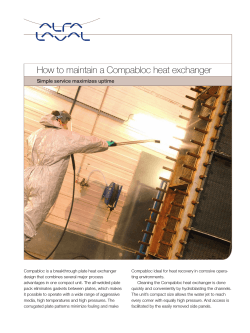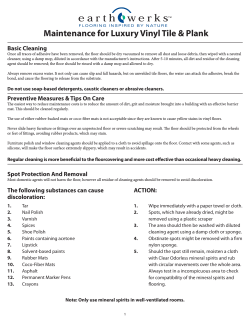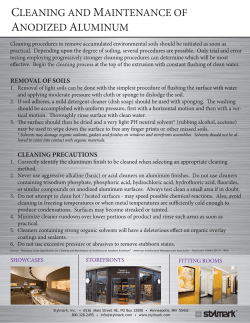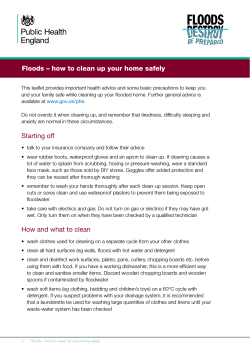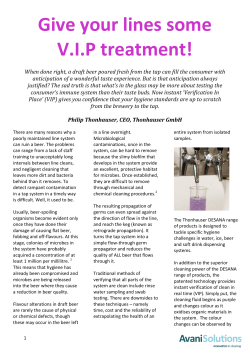
What is Cleaning in Place? How does it work, and... should you use it? A basic primer from Burkert White Paper
What is Cleaning in Place? How does it work, and where should you use it? A basic primer from Burkert White Paper September 2011 What is Cleaning in Place? How does it work, and where should you use it? A basic primer from Burkert Timo Bleschke, Product manager pneumatic and process interfaces, Bürkert Fluid Control Systems Cleaning in Place (CIP) has been around for approximately 50 years, and is commonly used in hygiene critical industries, such Food, Beverage and Pharmaceutical, to clean a wide range of plant. CIP refers to the use of a mix of chemicals, heat and water to clean machinery, vessels or pipe work without dismantling plant. The process can be one shot, where everything goes to drain, or recovery, which recycles most of the liquid. Overall, CIP can be a very efficient way of cleaning. The principles of CIP can be applied to any industry and plant where hygiene is critical; and the process is usually an integral part of any automated plant. Increasing Health and Safety legislation is set to make CIP more common, which is a good thing because a shiny surface on the outside of plant is no guarantee of cleanliness on the inside. CIP is principally concerned with soil removal: soil being anything that should not be present in a clean vessel. Soil can cause tainting and can often be smelt. It can be visible (scale, foreign bodies,) or invisible in the form of bacte- Perfektion für sanfte Operationen 2 ria, such as E Coli, or Yeast spores. The time needed to remove soil is at least 15 minutes using a suitable chemical (strength dependent on chemical supplier and product) at temperatures above 50 degrees C, but no greater than 75 degrees C because there is no advantage to be gained above this temperature. Cleaning agents Commonly used chemicals for soil removal include In der Pharmazeutik werden hohe Anforderungen an CIP gestelllt Caustic Soda, Phosphoric and Nitric acids, Sodium Hypochlorite (Hypo) and Peracetic Acid (PAA). Caustic Soda is an alkali typically used at 0.5% - 2% volume. It reacts with the fats in the soil and softens it for removal. One downside is that Caustic Soda is not effective for removing scaling. In addition, sequestriants are often added to keep soiling in solution. Phosphoric and Nitric Acids are used in detergent formulations for scale removal, often at lower temperatures than Caustic. These acids must be used with care as they can attack valve and pump seals. They are often used in dairies for one week in every 6 weeks to remove milk scale, and can be used after commissioning to remove installation debris. Sodium Hypochlorite (Hypo) offers the advantage of a very low cost. It is used primarily for disinfection because its ability for soil removal is poor. The active ingredient of Hypo is Chlorine (Bleach). This can corrode Stainless Steel in high concentrations and will attack seals and personnel. It will also taint if not rinsed out; and is dangerous if mixed with acid, forming Chlorine gas, which is poisonous. PAA is an equilibrium mixture of acetic acid and hydrogen peroxide. It is a powerful oxidising agent with an oxidation capacity higher than sodium hypochlorite and chlorine dioxide, and is comparable to the oxidative capacity of ozone. PAA at 75 mg/L is reported to successfully kill 100% of a 10(7) cell/ml yeast or bacterial population in 30- seconds. Perfektion für sanfte Operationen 3 CIP Line & Vessel Cleaning When cleaning lines in process equipment using CIP, the correct fluid velocity must be achieved to obtain good cleaning. Laminar flow, from velocities below 1.5m/sec does not give good cleaning characteristics. What is required is turbulent flow at velocities between 1.5-2.1 m/sec. There is no gain at velocities above 2.1 m/sec. In the cleaning of vessels two main methods are generally employed. The first uses high pressure cleaning heads to remove soil by mechanical action: the vessel surface being contacted in a series of passes. The second method employs low pressure cleaning heads that rely purely on chemical action to remove the soiling. CIP Return The majority of problems with CIP can be attributed to poor CIP return. This causes excessive CIP times, excessive use of detergent and heat with high effluent discharge. To overcome these problems the system for Return must quickly and efficiently return the cleaning solutions back to the CIP Set. Critical in this respect is the choice of scavenge pump. Zuleitung von einem CIP-System zu dem Bereich der Anlage, in dem die Reinigung durchgeführt werden soll Poor scavenge allows back up of cleaning solution and poor cleaning of the lower part of the vessel. In contrast, effective scavenge allows fresh cleaning solutions to contact the vessel walls and carry away soil effectively. CIP Optimisation Most CIP sequences are never altered from post installation settings; these are usually a set of “defaults” which are set on commissioning. However CIP operators can optimise their systems by monitoring a number of key parameters. These are: • What temperature and concentration (conductivity) are the Caustic tanks set to? - often set too high with no added benefit. • Consider the Pre-Rinse – does it run clear and then keep going? Perfektion für sanfte Operationen 4 • Caustic Fill – how high are the Return Conductivity and Temperature Transmitters set? • Intermediate Rinse – is it removing caustic solution and temperature prior to sterilisation? • Sterilisation – what strength is the sterilising agent and how long is the contact time? Finally all changes resulting from the CIP monitoring process should be documented and validated to meet any statutory regulations, and/or specific client requirements. Case study Burkert Saves £120,000 per annum - or 40% - in CIP costs for major pharmaceutical manufacturer Converting a manual CIP process to automatic across 80 reaction vessels, using pressure transmitters, condition sensors and flow meters, has enabled Burkert to achieve savings of £120,000 per annum for a major UK pharmaceutical manufacturer. Prior to the installation of the Burkert system, the reaction tanks were each cleaned for 6-hrs, constantly flushed to drain with hot Beispiel eines kompakten CIP-Systems, hier komplett ausgestattet mit Komponenten von Bürkert water at 700C. This was a purely manual process based upon operator experience, rather than positive signals from the process that the cleaning procedure was complete. The weekly costs for the manual cleaning procedure were substantial: energy costs were running at around £4000, with water at approximately £1,000 and effluent costs approaching the same figure. In total, the combined weekly figure across all activities included in the cleaning was £5,900; or a considerable £295,000 per annum. Perfektion für sanfte Operationen 5 Keen to reduce these costs, engineers at the pharmaceutical manufacturer contacted Burkert. This resulted in a site visit to view the manual CIP process. Following the visit Burkert suggested a solution for each reaction vessel based upon a Type 8311 pressure transmitter, a Type 8222 condition sensor and a Type 8041 flow sensor. These products were installed on a test group of the vessels and linked the plant SCADA system. The CIP process was then undertaken in an automatic mode, with the 8222 condition monitor providing effective feedback of when the water in the vessel was clean – and hence the vessel itself – to the SCADA system, which terminated the process. Der Einsatz des Bürkert-Systems wird beim Anwender vorraussichtlich zu jährlichen Einsparungen bei der CIP-Reinigung von 40 % führen equipment. On the basis of the initial tests, engineers at the pharmaceutical plant calculated that their CIP costs would be reduced by 40%, or £120,000 per year using the Burkert “This application highlights the savings that can be achieved on even the simplest of processes, as a result of consulting our specialist engineers,” said Burkert UK Sales Manager, Neil Saunders. “All business sectors today are incredibly competitive, so all opportunities to exploit so-called ‘low hanging fruit’ have to taken and optimised upon. With our specialist knowledge and leading edge product range this is exactly what we do: and the results speak for themselves, as evidenced by this application.” Perfektion für sanfte Operationen 6 Contact How can we help you to optimise your CIP systems? Any further questions? Then just contact us: Timo Bleschke Product management pneumatic and Process interfaces Bürkert Fluid Control Systems Bürkert Werke GmbH Christian-Bürkert-Straße 13-17 74653 Ingelfingen Tel: +49 7940 10-0 E-Mail: Timo.Bleschke@buerkert.com Website: www.buerkert.com Perfektion für sanfte Operationen 7
© Copyright 2025

